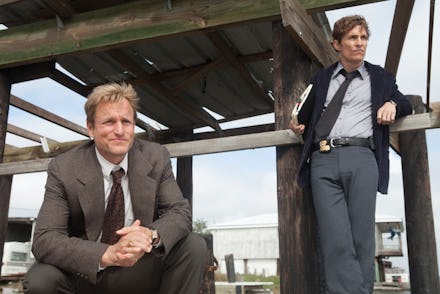The Final 6 Minutes of Sunday's 'True Detective' May Be One of the Greatest Scenes in TV History

The news: On Sunday, HBO’s somber cop drama True Detective entered the “best shot in TV history” conversation with an uninterrupted six-minute tracking take. Critics have hailed it as the long-awaited moment when television and film craft became indistinguishable – one of the more "cinematic" moments to ever grace the small screen.
The shot follows Matthew McConaughey’s character, Detective Rust Cohle, as he helps a biker gang called the Iron Crusaders rob a stash house hidden in the walls of a low-income housing project in Beaumont, Texas. Two factors inform Cohle’s state of mind here: First, he’s undercover, and grudgingly agrees to participate in the robbery in exchange for access to a meth cook, who might be involved in the murder he’s investigating. The second is that he’s been snorting copious amounts of cocaine, some of it cut with another unnamed substance. “You’ll like it,” says Ginger, his biker acquaintance.
The long take captures Cohle’s addled detachment in all its sweaty, wide-eyed glory, while its smooth continuity complements his verbal attempts to keep calm despite a frantic situation: "In and out," he repeats to himself over and over again, like a mantra. "In and out." It’s by far the most memorable scene in the series, perhaps this entire season of television.
But shots like this have historical significance as well. Cary Joji Fukunaga, the director responsible for True Detective’s first season, knew he wanted to do a long take even before reading Nic Pizzolatto’s script. He’s no stranger to the method: He employed it in his feature films Sin Nombre and Jane Eyre, and calls it “the most first-person experience you can get in a film.”
Such shots are historically recognized as a director’s opportunity to show off. The complications involved in choreographing them require incredible skill and patience: Fukunaga says this sequence took seven attempts over the course of a day and a half – quick by film standards, but tough to do on a truncated TV shooting schedule. Notable precedents include the opening shot of Orson Welles’ 1958 noir classic Touch of Evil, and a celebrated sequence in Martin Scorsese’s Goodfellas (1990). Alfonso Cuarón, director of Gravity, uses the method often as well, mostly famously in his apocalyptic drama Children of Men. However, Alexander Sokurov might take the cake with his film Russian Ark (2002): He filmed the entire 96 minutes in one long tracking shot.
Why is this important? Consider True Detective Fukunaga’s attempt to throw his hat into the ring with these other renowned directors. That he did it on TV adds yet another element to an already powerful cinematic moment, and will undoubtedly remain a subject of discussion for years to come. With four more episodes left this season, it’ll be exciting to see what other surprises he has in store.